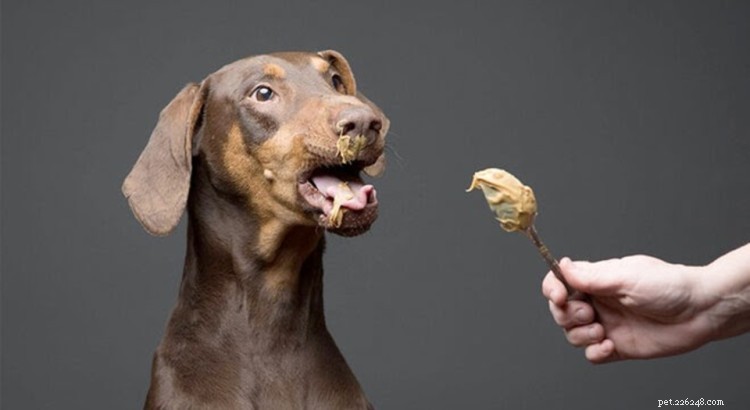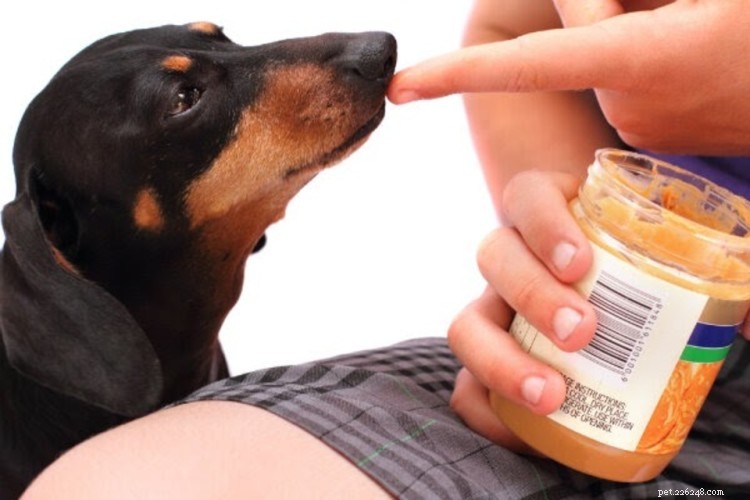Os cães podem comer manteiga de amendoim? Apenas se for livre de xilitol
Não há dúvida de que os filhotes adoram manteiga de amendoim, mas é realmente bom para eles? Mesmo que a manteiga de amendoim seja um ingrediente em muitas guloseimas comerciais para cães, a resposta pode surpreendê-lo.
Embora existam muitas marcas de manteiga de amendoim que são inofensivas para o seu companheiro canino, certos tipos contêm ingredientes que podem ser prejudiciais aos cães. Portanto, antes de deixar seu cão comer manteiga de amendoim, há alguns fatos que você precisa saber.
Dica profissional :Seu cão conseguiu esvaziar um pote de manteiga de amendoim quando você não estava assistindo? As contas do veterinário podem ser caras, mas ter uma apólice de seguro para cães cobrirá os impactos de seu animal de estimação ingerir ingredientes potencialmente tóxicos e lhe dará alguma paz de espírito.
 Fonte da imagem:Pin Paws
Fonte da imagem:Pin Paws A manteiga de amendoim é boa para cães?
A manteiga de amendoim é embalada com proteínas, gorduras naturais, vitaminas E, B e niacina. No entanto, grandes quantidades podem resultar em obesidade, bem como em outros problemas de saúde, como pancreatite.
A quantidade de pasta de amendoim dependerá do cão individual, bem como da marca da pasta de amendoim (certifique-se de verificar a contagem calórica no rótulo). Em geral, cães maiores devem receber uma colher de sopa, enquanto os menores não devem receber mais do que meia colher de sopa por dia.
Chame seu veterinário para discutir se a manteiga de amendoim é segura para seu animal de estimação e quanto você deve dar. Isso é especialmente importante para filhotes com condições médicas subjacentes, como diabetes, sensibilidade alimentar ou pancreatite crônica.
Outra coisa a levar em consideração é a quantidade de manteiga de amendoim que você está servindo. Lembre-se da regra 90/10:10% da dieta do seu cachorro deve consistir em guloseimas e os 90% restantes devem ser a ração regular. Além disso, pode ser uma boa ideia alternar entre manteiga de amendoim e guloseimas mais saudáveis, como frutas e vegetais seguros para cães.
Quais cães devem ficar longe da manteiga de amendoim?
-
Para filhotes com pancreatite crônica ou aqueles em risco de desenvolver pancreatite, como Yorkshire Terriers e Schnauzers Miniatura - mesmo uma pequena quantidade de guloseimas com alto teor de gordura, como manteiga de amendoim, pode ser suficiente para causar ou piorar sua condição, por isso deve ser evitada completamente.
-
Se o seu amigo peludo é sensível ou alérgico a alguns alimentos ou foi prescrita uma dieta especial, é melhor ficar seguro alimentando-os com o que eles costumam comer.
-
Filhotes com problemas renais não deve comer manteiga de amendoim, pois pode conter altos níveis de sal que podem piorar sua condição
-
A manteiga de amendoim contém cerca de 180-200 calorias por duas colheres de sopa – a maioria vem da gordura. Isso o torna menos ideal para animais de estimação com excesso de peso . Se você estiver procurando por guloseimas de treinamento, opte por alternativas mais magras, como atum, frango e presunto.
Que tipo de manteiga de amendoim é melhor para o seu cachorro?
Se você deseja escolher a melhor opção de manteiga de amendoim, verifique o rótulo quanto a conservantes e açúcar extra. Algumas marcas também contêm sal adicionado, o que as torna ricas em sódio, bem como certas gorduras, como óleo de palma. Sua melhor aposta é encontrar uma marca de manteiga de amendoim livre de aditivos ou preparar sua própria versão caseira com apenas um ingrediente - amendoim.
Ao ler o rótulo, tenha cuidado com termos como "100% natural" ou "sem adoçantes artificiais". O xilitol é tecnicamente um adoçante "totalmente natural", mas pode ser extremamente tóxico para o seu companheiro peludo!
Os perigos do xilitol
O xilitol é um substituto do açúcar encontrado em produtos sem açúcar, como creme dental, produtos de panificação, suplementos, sorvetes e gomas de mascar. Este adoçante artificial é perfeitamente seguro para humanos, mas pode ser muito tóxico para cães.
Mesmo uma quantidade extremamente pequena pode causar uma liberação rápida de insulina que, por sua vez, resulta em uma rápida diminuição dos níveis de açúcar no sangue. Essa condição (hipoglicemia) pode ocorrer tão rapidamente quanto uma hora após o consumo de xilitol e, se não for tratada, pode ser fatal.
Se o seu amigo peludo comer um produto contendo xilitol, ele pode apresentar os seguintes sintomas:
- Respiração rápida
- Gengivas pálidas
- Diarréia
- Mudança na temperatura corporal
- Pulso rápido ou fraco
- Problemas para ficar de pé
- Caminhada escalonada
- Insuficiência hepática
- Inconsciência
- Convulsões
Se você notar algum desses sintomas, certifique-se de procurar tratamento médico imediatamente. On your way to the vet, you can try to raise their blood sugar by rubbing maple or corn syrup on their gums, but this is only a temporary solution.
 Image source:Dogster
Image source:Dogster What Else to Watch out For
Besides xylitol, peanut butter can contain other ingredients that can pose a threat to your dog’s health.
Aflatoxins
Most peanut butter contains aflatoxins, one of the most carcinogenic substances on the planet. Research has shown that aflatoxin can cause liver cancer in laboratory animals and is a risk for your pet as well. What’s worse, this toxic ingredient is even more common in the organic alternatives, as they’re not sprayed with glyphosate or other chemicals that kill it.
On the other hand, glyphosate, which is a common herbicide used by many major brands, can also cause health issues in dogs. According to NPIC, glyphosate symptoms in dogs include vomiting, diarrhea, lethargy, weight loss, and excessive drooling. Tests have also shown that 15% of dogs who eat grass treated with glyphosate herbicides develop serious symptoms of toxic reaction.
Lectins
Lectins are proteins that can cause gut inflammation, irritating the cells lining the digestive tract and causing them to open up. This condition is called a leaky gut. When leaky gut is present, lectins escape into the bloodstream, where they trigger an inflammatory response. If inflammation persists, it might lead to chronic organ disease like arthritis, heart disease, kidney disease, allergies, and cancer.
Lectins also bind to sugars and carbohydrates in the body and interrupt messaging between inflammatory reactions and cells. In addition, they are anti-nutrients, i.e. they interfere with the proper absorption of important proteins, vitamins, and minerals.
Unbalanced fats
You’ve probably heard that peanuts are rich in good omega-3 and omega-6 fats. The problem is, the ratio of these fats in peanut butter is highly unbalanced:a cup of peanuts contains 35.578 mg of omega-6 and only about 195 mg of omega-3s. That’s about 5000 times more omega-6 than omega-3!
When it comes to good fats, they’re only good if consumed in the correct ratio. Too much omega-6 can raise blood pressure, lead to blood clots, and cause the body to retain water. Omega-6 fatty acids are already represented in most of the foods your furry pal is exposed to, so feeding them peanut butter can only make things worse.
Harmful fats
Trans-fatty acids are the result of hydrogenation, a process that makes foods more stable and more durable. They have been linked to chronic inflammation that can cause a number of diseases like heart disease and diabetes.
That’s why you need to check the label before buying peanut butter for your pooch. If you spot the words ‘hydrogenated’ or ‘partially hydrogenated oils’ in the ingredient list, stay away from it.
Sugar
White sugar is responsible for feeding nasty things like bacteria, yeast, parasites, and even cancer cells. This means that the more sugar we (and our furry friends) consume, the more these grow and spread. Sugar can also lead to diabetes, premature aging, low-level inflammation, and food allergies.
Can Dogs Be Allergic to Peanuts?
While sudden, severe allergic reactions typical in people suffering from nut allergies are rare in dogs, other allergic symptoms might occur. To stay on the safe side, if you are feeding peanut butter for the first time, start with a very small amount and monitor your pet.
Signs of a chronic food allergy in dogs include:
- Thin fur coat
- Recurrent ear infections
- Recurrent problems with anal glands
- Chronic itchiness
Signs of an acute allergic reaction in dogs include:
- Vômitos
- Diarréia
- Difficulty breathing or rapid breathing
- Severe itchiness
- Hives
- Swelling around their muzzle and/or eyes
- Recolher
If you notice these symptoms after feeding peanut butter to your four-legged friend, stop immediately and get in touch with your veterinarian, who will be able to help figure out whether your pet is allergic to peanuts or something else. Also, make sure to speak to your vet before introducing any new foods to your dog’s diet.
Compare pet insurance policies to help you manage vet bills that might occur from treating an allergic reaction in your canine companion.
Is PB&J Safe for Dogs?
Enjoying your PB&J sandwich and wondering whether you should share it with your pooch?
While peanut butter can be safe for your four-legged friend if given in moderate amounts, jelly is an absolute no-no. This is because jelly, jam, and preserves contain lots of sugar. So, if you are already treating your dog with peanut butter, adding more sugar will increase the risk of diabetes and obesity even more.
Some jelly brands also contain xylitol and some types are made from fruits that aren’t dog-safe, like grapes. Grapes (as well as currants and raisins) can be toxic to dogs and cause acute kidney failure.
 Image source:PetMD
Image source:PetMD Ways to Treat Your Doggy With Peanut Butter
Here are a few fun ways to feed peanut butter to your four-legged pal:
Use it to give medication . Giving medication is often stressful as most pups won’t eat it plain. Use peanut butter’s deliciousness to conceal the flavor and texture of pills.
Make bathtime less stressful . Smear some peanut butter on the wall of your shower or tub to distract your pup during bath time (or while clipping their nails). They’ll be busy licking it and less focused on being shampooed, making the whole experience a lot easier for both of you.
Sweeten the entertainment . Fill a treat toy with some peanut butter and let your high-energy furry companion lick during chill out time.
Use it for training . Give some peanut butter to your pooch after they have shown good behavior or done what they were asked to do. This will make them more likely to do good again next time as they’ll remember getting an extra tasty treat.
Considerações finais
The bottom line is, your canine companion can eat peanut butter as long as it’s fed in moderation and doesn’t contain xylitol . Don’t forget to alternate peanut butter with other healthy treats and you’ll make sure that your pup is satisfied.
If you have any questions or concerns about your pet’s diet, get in touch with your vet for recommendations and advice.

